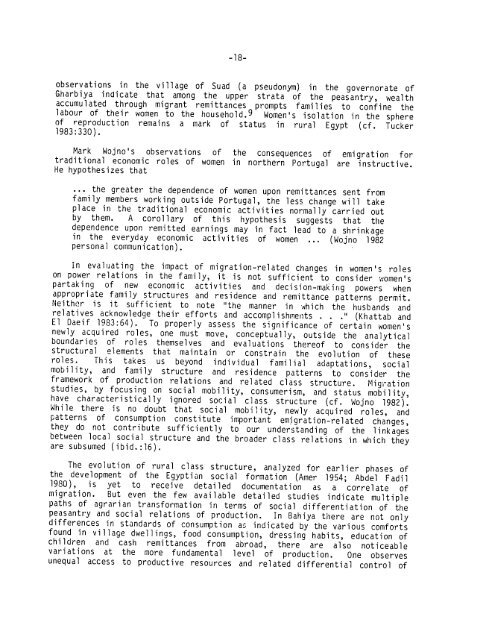FAMILIAL ADAPTATIONS TO THE INTERNATIONALIZATION OF ...
FAMILIAL ADAPTATIONS TO THE INTERNATIONALIZATION OF ...
FAMILIAL ADAPTATIONS TO THE INTERNATIONALIZATION OF ...
Create successful ePaper yourself
Turn your PDF publications into a flip-book with our unique Google optimized e-Paper software.
-18<br />
observations in the village of Suad (a pseudonym) in the governorate of<br />
Gharbiya indicate that among the upper strata of the peasantry,<br />
accumulated<br />
wealth<br />
through migrant remittances prompts families to confine the<br />
labour of their women to the household. 9 Women's isolation in the<br />
of<br />
sphere<br />
reproduction remains a mark of status in rural Egypt (cf. Tucker<br />
1983:330).<br />
Mark Wojno's observations of the consequences of emigration for<br />
traditional economic roles of women in northern Portugal are instructive.<br />
He hypothesizes that<br />
... the greater the dependence of women upon remittances sent from<br />
family members working outside Portugal, the less change will take<br />
place in the traditional economic activities normally carried out<br />
by them. A corollary of this hypothesis suggests that the<br />
dependence upon remitted earnings may in fact lead to a shrinkage<br />
in the everyday economic activities of women ... (Wojno 1982<br />
personal communication).<br />
In evaluating the impact of migration-related changes in women's roles<br />
on power relations in the family, it is not sufficient to consider women's<br />
partaking of new economic activities and decision-making powers when<br />
appropriate family structures and residence and remittance patterns permit.<br />
Neither is it sufficient to note "the manner in which the husbands and<br />
relatives acknowledge their efforts and accomplishments . ." (Khattab and<br />
El Daeif 1983:64). To properly assess the significance of certain women's<br />
newly acquired roles, one must move, conceptually, outside the analytical<br />
boundaries of roles themselves and evaluations thereof to consider the<br />
structural elements that maintain or constrain the evolution of these<br />
roles. This takes us beyond individual familial adaptations, social<br />
mobility, and family structure and residence patterns to consider the<br />
framework of production relations and related class structure. Migration<br />
studies, by focusing on social mobility, consumerism, and status mobility,<br />
have characteristically ignored social class structure (cf. Wojno 1982).<br />
While there is no doubt that social mobility, newly acquired roles, and<br />
patterns of consumption constitute important emigration-related changes,<br />
they do not contribute sufficiently to our understanding of the linkages<br />
between local social structure and the broader class relations in which they<br />
are subsumed (ibid.:16).<br />
The evolution of rural class structure, analyzed for earlier phases of<br />
the development of the Egyptian social formation (Amer 1954; Abdel Fadil<br />
1980), is yet to receive detailed documentation as a correlate of<br />
migration. But even the few available detailed studies indicate multiple<br />
paths of agrarian transformation in terms of social differentiation of the<br />
peasantry and social relations of production. In Bahiya there are not only<br />
differences in standards of consumption as indicated by the various comforts<br />
found in village dwellings, food consumption, dressing habits, education of<br />
children and cash remittances from abroad, there are also noticeable<br />
variations at the more fundamental level of production. One observes<br />
unequal access to productive resources and related differential control of
















